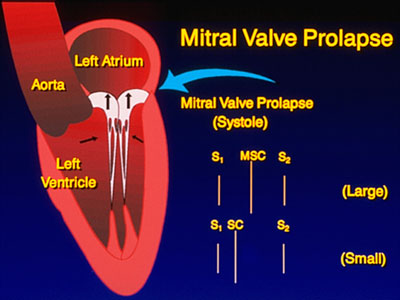
Midsystolic Click – Mitral Valve Prolapse

The words "midsystolic click" are virtually synonymous with prolapse of the mitral valve toward the left atrium during systole. It is most commonly the result of myxomatous degeneration of the valve with prolongation of the valve and/or chordae tendinae. The central problem lies in an abnormal ratio between the length of the mitral apparatus and the volume of the left ventricular chamber. The mitral valve is “too long” for the size of the ventricular chamber.
Therefore, as ventricular systole proceeds and ventricular volume declines, the valve cannot be held in place. The valve then slips and as it is caught again to be held in place by subvalvular tissue, the sudden cessation in motion creates a high frequency sound, the midsystolic click.
The midsystolic click may actually occur at almost any time during systole depending upon the length of the mitral apparatus and the volume of the left ventricle. Therefore, the time at which the click occurs may be manipulated by a variety of maneuvers. It is this manipulation of timing and, occasionally, precipitation of a murmur of mitral regurgitation following the click that assures diagnosis.
At rest, the midsystolic click is usually just that. As a result, the cadence, heard with the diaphragm of the stethoscope, over the apical impulse, is “ta ta ta”. When such a sound is heard and mitral prolapse suspected, the patient should be subjected to maneuvers to confirm the diagnosis. First, the Valsalva maneuver: during the strain phase of the Valsalva maneuver, ventricular filling is reduced and the left ventricle begins systole at a smaller volume. Therefore, the time at which prolapse will occur moves toward the first heart sound. Additionally, as you will hear in the recording, the different components of the mitral valve may occur at different times giving rise to multiple clicks. In some instances, multiple clicks occurring very close together may mimic a systolic murmur.
A maneuver that is easier to perform and examine is the squatting to standing maneuver. Upon standing, approximately 600 ml of blood are left in the veins of the legs reducing left ventricular volume and bringing the click nearer to the first heart sound. When resuming the squatting position, increased afterload and augmentation of venous return increase left ventricular volume, moving the click away from S1 toward midsystole or even later.
Other maneuvers that may be useful include handgrip (increased afterload and increased ventricular volume) and amyl nitrate (decreased afterload and smaller ventricular volume). Should you confirm your diagnosis by auscultation and maneuvers, do not be discouraged by a report of a normal echocardiogram. The echo is limited by imaging windows, but with your stethoscope, you can listen to the whole mitral valve.

Return to Heart Sounds Podcast Series
Updated February 2009